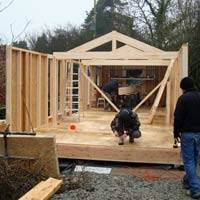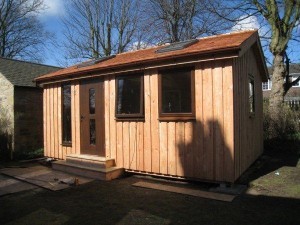Getting planning permission for a garden building is sometimes necessary and always straightforward.
Permitted development allows you to build ‘incidental structures such as sheds and summerhouses without Planning Permission. Whether or not you need planning permission for a garden office depends on how you intend to use your building.
 Planning permission for garden offices
Planning permission for garden offices
An office used as an home study combined with other leisure uses may not need Planning Permission if it meets other permitted development criteria. We explain permitted development rules and how they relate specifically to garden offices here – garden office planning permission
Planning permission for garden rooms
A garden office used for occasional or ‘incidental’ leisure use such as a studio or gym that meets permitted development requirements shouldn’t need Planning Permission. But, it’s vital to double check with your planning department and we will do this for you.
Planning permission for granny annexes
You’ll always and without exception need Planning Permission. See our page about granny annexes and planning permission.
Permitted Development
What is Permitted Development?
Permitted development is building work that you can do to your home without needing planning permission. Only a garden office or studio that ha an “incidental” use can be built without planning permission. Incidental use can be loosely defined as things you don’t do in your main house. Hobbies are often viewed as incidental use, as are storage, gym and other occasional uses and even then, the garden building has to meet various constraints re size and position.
If your building has an “ancillary” use it may need planning permission. Ancillary uses are such things as sleeping, showering. I.E. Things that you can also do in your house.
What does “incidental” mean?
The meaning of “incidental” in planning permission legislation has never been accurately defined. Traditionally an “incidental” building is a garden shed, summer house or a greenhouse – a building that you will use ocasionally to perform tasks that you can’t perform in your house.
If you build a general purpose garden office that you may sometimes use as a home office, most local authority planning departments will view this as “incidental”, but some won’t. So talk to your local planning department.
A garden building that contain plumbing
In our experience, a garden office or garden room that contains plumbing will need planning permission, though some local authorities may be happy with a Certificate of Lawful Development.
Permitted development guidelines – England and Wales
A garden office or studio is considered to be permitted development, not needing planning permission, if it meets the following requirements:
- No garden building built on land forward of a wall forming the principal elevation of the main house.
- Outbuildings should be single storey with a maximum eaves height of 2.5 metres and maximum overall height of four metres with a dual pitched roof.
- A garden room must have a maximum height of 2.5 metres if it is built within two metres of the garden boundary.
- No verandas, balconies or raised platforms – including decking of more than 300mm high..
- No more than half the area of land around the “original house”* would be covered by additions or other buildings.
- In National Parks, the Broads, Areas of Outstanding Natural Beauty and World Heritage Sites the maximum area to be covered by buildings that are more than 20 metres from house must be limited to 10 square metres.
- On designated land* garden buildings at the side of properties will require planning permission.
- Within the curtilage of listed buildings any outbuilding will require planning permission.
*The term “original house” means the house as it was first built or as it stood on 1 July 1948 (if it was built before that date). Although you may not have built an extension to the house, a previous owner may have done so.
*Designated land includes national parks and the Broads, Areas of Outstanding Natural Beauty, conservation areas and World Heritage Sites.
Permitted development guidelines – Scotland
Permitted development rights in Scotland allow for the provision of any building required for a purpose incidental to the enjoyment of the dwellinghouse. Typical developments include sheds, garages, sun-houses and greenhouses. In summary, the effect of the limitations is that:
- Ancillary buildings are generally located to the rear.
- At least half the curtilage remains undeveloped.
- The height of the building is not higher than 4 metres and the sections within 1 metre of the boundary would not be higher than 2.5 metres.
- The height of the eaves is not higher than 3 metres.
In the case of dwellinghouses in aconservation area or within the curtilage ofa listed building development is permitted developmen t as long as the footprint of the ancillary building does not exceed 4 square metres. Listed building consent is required if the proposed development affects the character or setting of a listed building.
Granny Annexes

Do I need planning permission for my granny annexe?
Yes.
Do I need planning permission for a garden guest room?
Yes.
If a garden building is intended for sleeping in regularly it will definitely need planning permission.
It must also meet current building regulations. -link to building regs page
Working at Home
Running a business from home
Sometimes you need planning permission to run a business from home – regardless of whereabouts in the home you work. The key test is whether the overall character of the dwelling will change as a result of the business.
If the answer to any of the following questions is ‘yes’, then permission will probably be needed:
- Will your home no longer be used mainly as a private home?
- Will your business result in a noticable rise in traffic or people calling?
- Will your business involve any activities that are unusual in a residential area?
- Will your business disturb your neighbours at unreasonable hours or create other forms of nuisance such as noise or smells?
Whatever business you carry out from your home, whether it involves using part of it as a bed-sit or for ‘bed and breakfast’ accommodation, using a room as your personal office, providing a childminding service, for hairdressing, dressmaking or music teaching, or using buildings in the garden for repairing cars or storing goods connected with a business – the key test is: is it still mainly a home or has it become business premises?
If you are in doubt you may apply to your council for a Certificate of Lawful Use for the proposed activity, to confirm it is not a change of use and still the lawful use.
Do I need planning permission for my garden office building?
If you can answer no to the above questions you probably don’t need planning permission to run your business from home, but you may still need planning permission to build your garden office.
Building Regs
What are Building Regulations?

Planning permission and Building Regulations are not the same thing: –
Building regulations govern the quality and technical design of a structure. The fire proofing, the structural integrity, the amount of insulation, the solidity of the foundations.
Planning permission governs the relationship of a building to its surroundings. The position, external appearance and size of the structure.
Will my garden room or garden office have to comply?
A garden office or garden room with less than 15 sq metres of internal floor space does not have to meet building regulations unless it is used as sleeping accommodation.
A garden building with less than 30sq metres of internal floor space, if it is positioned more than a metre from the garden boundaries does not need to meet building regulations unless it will be used as sleeping accommodation.
Do garden guest rooms have to meet Building Regulations?
Yes, if it is built specifically for use as a bedroom it must meet building regulations. Whatever the size of the building.
And granny annexes?
Yes, if it is built specifically for use as living/sleeping accommodation it must meet building regulations.
Who will make the application?
Your garden buildings supplier should make the application for you because he is in control of the technical specification of your building.
